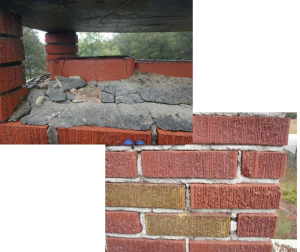Your chimney has NEVER leaked before! Why now? Well we’ve gotten more rain around here than we’ve had in 200 years, and the sad fact is – a chimney is just a big sponge. Like a sponge — when it gets saturated, the water will run out anywhere and anyhow it can. When that much water is getting into a chimney, if it is not dealt with, over time the chimney structure can become compromised – not to mention all the places water can leak out to in the meantime.
compromised – not to mention all the places water can leak out to in the meantime.
If you’d like to know more about water’s effects on masonry chimneys, please feel free to check out CSIA.ORG.
Sometimes it is obvious where the water entry is, sometimes not so much. Water leaks are often difficult to diagnose as to the exact cause. Usually there is more than one problem. A visual inspection can reveal likely possibilities and probable remedies. Sometimes where the water is being seen can indicate one or more of the four most common sources as being the most likely point of entry. In other cases, it is a trial and error process to pinpoint the source.
Most Common Points of Entry
- Open or inadequately covered flues
- Improper or deteriorated crown wash
- Absorption through brick due to
- Porous brick and/or mortar
- Faulty or deteriorated mortar joints
- Flashing that is faulty or deteriorated
- Absence of cricket
Blue Sky Chimney Sweeps|Bless Your Hearth offers products and methods to address these problems.
- A full coverage chimney cap, preferably with a lid that overhangs the sides of the chimney, can prevent rain from entering the flue and provide added protection for crown.**
- An elastomeric coating can seal the crown wash or a cast and poured crown with a drip edge can be created. Either option helps prevent water from freely soaking in from the top.
- A breathable water repellant and/or crack sealer designed for chimneys applied to the brick and mortar can prevent water from soaking in from the sides.
- Deteriorated mortar joints can be tuck-pointed.
- Complete rebuild may be necessary if chimney is too deteriorated to repair.
- Metal flashing can be repaired or replaced; or a flexible, surface bonded flashing can be applied to correct improper or deteriorated flashing.
- A cricket can be added to the roof at the base of a chimney where indicated.
How do you know if it’s the chimney or the roof?
Wrap the chimney with plastic and wait for rain. (Not a long wait these days.) If it does not leak while it is wrapped, that is a good indication that the leak is indeed the chimney itself and not coming from some other source. If the leak is still there, it may be that the leak that appears to be the chimney is actually a leak in the roof, uphill from the chimney and water is running down to the chimney.
**More information from Blue Sky Chimney Sweeps|Bless Your Hearth about chimney caps can be seen here:
Chimney Caps & Animal Guards
Two-for-One

